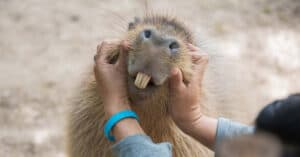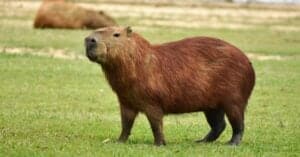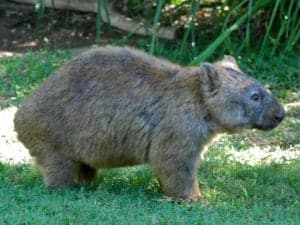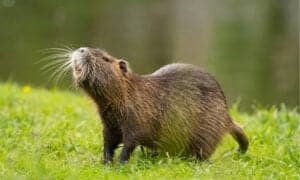Do Capybaras Make Good Pets? Sweet Rodents with Special Needs
@media (min-width: 481px) {
.mobile-top-content {
display: none;
}
}
#mobileTopContentCTACarouselControls { overflow: hidden; text-overflow: ellipsis; white-space: nowrap; }
.mobile-top-content .more { color: #fff; }
.mobile-top-content a { color: #fff; text-decoration: underline; }
.mobile-top-content a:hover { color: #fff; text-decoration: underline; }
@media (max-width: 480px) {
.mobile-top-content {
background-color: #06a10b;
color: #fff;
text-align: center;
/*height: 60px;
padding-top:5px;*/
font-size:80%;
/* display: block; */
margin: 0px -30px;
}
}
Capybaras are large water-loving rodents with sweet personalities. These gentle mammals native to Asia are adorable with short, square snouts and large incisor teeth, but do capybaras make good pets?
Capybaras are the biggest rodent on earth (weighing up to 170 lbs) in the same animal family as guinea pigs, called Caviidae. Adult capybaras can grow up to 4 feet long and 24 inches tall. Their compact bodies grow reddish-brown fur on their backs, turning to a yellowish hue on their bellies.
Capybaras are semiaquatic and need to spend about 50% of their time in the water. They are strong swimmers with webbed feet. Their front feet have four toes, but their back feet only have three. Capybaras have very dry skin requiring hydration through swimming every day.
Want to know more about capybaras and how to care for them as pets? Read on to learn how to house, feed, and keep capybaras healthy for their average lifespan of up to 10 years.
Do Capybaras Make Good Pets?

Pertfoto/Shutterstock.com
Capybaras make good pets because they are friendly wild animals, enjoy being petted, and are relatively easy to care for in the right conditions. In addition, most capybaras love being cuddled by their favorite humans. However, capybara pets need special housing, companionship, and food to enjoy life to the fullest in captivity.
Your capybaras need a closed-top enclosure (pen) with shelter and water for swimming. The enclosure should have plenty of space for multiple animals since it’s essential to adopt more than one capybara at a time. Additionally, the pond or pool dedicated to capybara use should be full and accessible 24 hours a day.
Capybaras are happiest in groups. They’re highly social animals who enjoy spending time with each other. They can be timid around humans at first, as they learn to feel comfortable around you and your family. However, giving them time to adjust will help you and your pets form an excellent bond over time.
Properly feeding your capybaras is extremely important for their health and longevity in captivity. A healthy capybara’s diet consists of about 80% grasses. You’ll need an excellent source of grass-based hay to feed your capybara pets.
What Does A Capybara Eat?
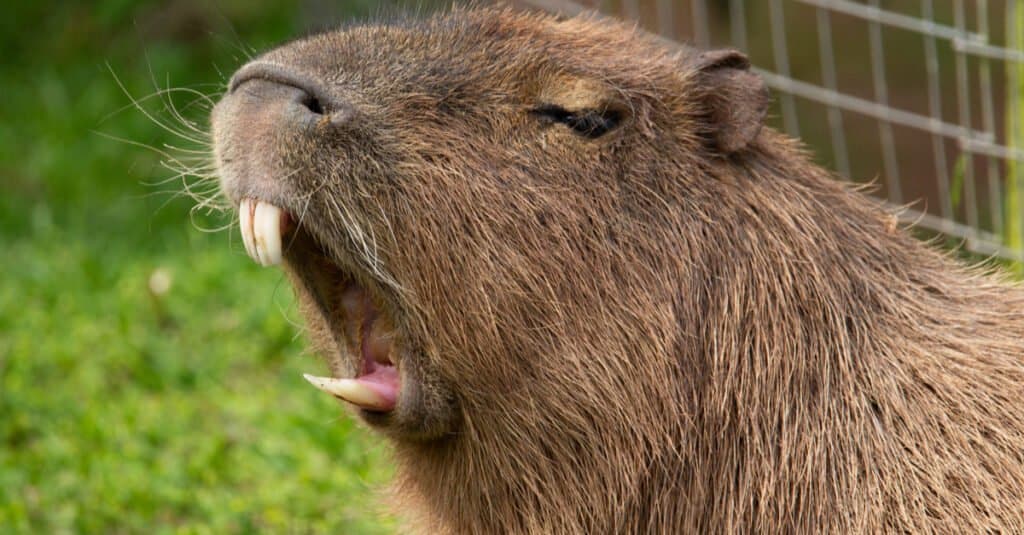
Ian Peter Morton/Shutterstock.com
Capybaras are herbivores and big eaters! Their diet is limited mainly to grasses and aquatic plants in the wild. Though, capybaras will occasionally eat roots, bark, and fruit. They need 6-8 pounds of food every day or roughly 3% to 4% of their body weight. A wild capybara’s favorite grasses include Bermuda grass, crowngrass, and switchgrass.
The best food for a capybara pet is quality grass hay made of Orchard or Timothy grasses. This type of premium grass hay should be available at feed stores for livestock. Capybaras are picky eaters, so feeding them low-quality hay isn’t recommended. However, high-quality food pellets created for rabbits and guinea pigs provide an easy supplement to their diet.
Capybaras love to forage and graze, so they thrive on ranch land or property with grassy fields. Though, whether grazing or munching on the food you provide, capybaras need to eat consistently to prevent the overgrowth of their large front teeth.
Don’t be alarmed if your pet capybaras eat their poop! Eating their feces provides extra protein to their diet. It’s important to allow them to eat it despite how disgusting that practice might seem.
Why Should I Adopt Only One Male Capybara?
Male capybaras are often aggressive with each other. For that reason, it’s best to adopt females only or have only one male in a pair or group.
How Do Capybaras Breed?

Andrew M. Allport/Shutterstock.com
If you intend to breed your capybaras, here are some common breeding habits you should know:
- When it comes to breeding, capybara females are in charge. The female whistles through her nose to indicate she’s ready to breed and will refuse any male she doesn’t like.
- Capybaras breed in the water. Make sure they have a well-maintained swimming pond or pool at least a few feet deep.
- Female capybaras are pregnant for about 130 to 150 days. They give birth to an average of four babies – called pups – per litter.
What Predators Hunt Capybaras?
Jaguars, ocelots, pumas, anaconda snakes, and harpy eagles hunt capybaras in their natural habitat. Thus, pet capybaras could be pursued by predators in your area. In particular, young capybaras are vulnerable to attacks by wolves, coyotes, foxes, and birds of prey like hawks and eagles.
Providing a durable closed-top enclosure at least four feet high protects pet capybaras from possible predator attacks.
Is it Expensive to Raise Capybaras as Pets?

iStock.com/nastenkin
Raising capybaras can be pretty costly, especially upfront. Capybaras are considered exotic pets and may require the cost of special licensing to adopt them where you live. The fees for buying a capybara from reputable breeders could be in the low thousands. Adding the considerable expense of providing their enclosure, shelter, and a large pool for swimming could wipe out even the healthiest budget.
Remember to also budget for the cost of specialized food for their lifetime and veterinary care from a vet with exotic animal experience.
More from A-Z Animals
.more-snake-card-image { max-height:140px !important; }
@media (min-width: 481px) {
.mobile-top-content {
display: none;
}
}
#mobileTopContentCTACarouselControls { overflow: hidden; text-overflow: ellipsis; white-space: nowrap; }
.mobile-top-content .more { color: #fff; }
.mobile-top-content a { color: #fff; text-decoration: underline; }
.mobile-top-content a:hover { color: #fff; text-decoration: underline; }
@media (max-width: 480px) {
.mobile-top-content {
background-color: #06a10b;
color: #fff;
text-align: center;
/*height: 60px;
padding-top:5px;*/
font-size:80%;
/* display: block; */
margin: 0px -30px;
}
}
Capybaras are large water-loving rodents with sweet personalities. These gentle mammals native to Asia are adorable with short, square snouts and large incisor teeth, but do capybaras make good pets?
Capybaras are the biggest rodent on earth (weighing up to 170 lbs) in the same animal family as guinea pigs, called Caviidae. Adult capybaras can grow up to 4 feet long and 24 inches tall. Their compact bodies grow reddish-brown fur on their backs, turning to a yellowish hue on their bellies.
Capybaras are semiaquatic and need to spend about 50% of their time in the water. They are strong swimmers with webbed feet. Their front feet have four toes, but their back feet only have three. Capybaras have very dry skin requiring hydration through swimming every day.
Want to know more about capybaras and how to care for them as pets? Read on to learn how to house, feed, and keep capybaras healthy for their average lifespan of up to 10 years.
Do Capybaras Make Good Pets?

Pertfoto/Shutterstock.com
Capybaras make good pets because they are friendly wild animals, enjoy being petted, and are relatively easy to care for in the right conditions. In addition, most capybaras love being cuddled by their favorite humans. However, capybara pets need special housing, companionship, and food to enjoy life to the fullest in captivity.
Your capybaras need a closed-top enclosure (pen) with shelter and water for swimming. The enclosure should have plenty of space for multiple animals since it’s essential to adopt more than one capybara at a time. Additionally, the pond or pool dedicated to capybara use should be full and accessible 24 hours a day.
Capybaras are happiest in groups. They’re highly social animals who enjoy spending time with each other. They can be timid around humans at first, as they learn to feel comfortable around you and your family. However, giving them time to adjust will help you and your pets form an excellent bond over time.
Properly feeding your capybaras is extremely important for their health and longevity in captivity. A healthy capybara’s diet consists of about 80% grasses. You’ll need an excellent source of grass-based hay to feed your capybara pets.
What Does A Capybara Eat?

Ian Peter Morton/Shutterstock.com
Capybaras are herbivores and big eaters! Their diet is limited mainly to grasses and aquatic plants in the wild. Though, capybaras will occasionally eat roots, bark, and fruit. They need 6-8 pounds of food every day or roughly 3% to 4% of their body weight. A wild capybara’s favorite grasses include Bermuda grass, crowngrass, and switchgrass.
The best food for a capybara pet is quality grass hay made of Orchard or Timothy grasses. This type of premium grass hay should be available at feed stores for livestock. Capybaras are picky eaters, so feeding them low-quality hay isn’t recommended. However, high-quality food pellets created for rabbits and guinea pigs provide an easy supplement to their diet.
Capybaras love to forage and graze, so they thrive on ranch land or property with grassy fields. Though, whether grazing or munching on the food you provide, capybaras need to eat consistently to prevent the overgrowth of their large front teeth.
Don’t be alarmed if your pet capybaras eat their poop! Eating their feces provides extra protein to their diet. It’s important to allow them to eat it despite how disgusting that practice might seem.
Why Should I Adopt Only One Male Capybara?
Male capybaras are often aggressive with each other. For that reason, it’s best to adopt females only or have only one male in a pair or group.
How Do Capybaras Breed?

Andrew M. Allport/Shutterstock.com
If you intend to breed your capybaras, here are some common breeding habits you should know:
- When it comes to breeding, capybara females are in charge. The female whistles through her nose to indicate she’s ready to breed and will refuse any male she doesn’t like.
- Capybaras breed in the water. Make sure they have a well-maintained swimming pond or pool at least a few feet deep.
- Female capybaras are pregnant for about 130 to 150 days. They give birth to an average of four babies – called pups – per litter.
What Predators Hunt Capybaras?
Jaguars, ocelots, pumas, anaconda snakes, and harpy eagles hunt capybaras in their natural habitat. Thus, pet capybaras could be pursued by predators in your area. In particular, young capybaras are vulnerable to attacks by wolves, coyotes, foxes, and birds of prey like hawks and eagles.
Providing a durable closed-top enclosure at least four feet high protects pet capybaras from possible predator attacks.
Is it Expensive to Raise Capybaras as Pets?

iStock.com/nastenkin
Raising capybaras can be pretty costly, especially upfront. Capybaras are considered exotic pets and may require the cost of special licensing to adopt them where you live. The fees for buying a capybara from reputable breeders could be in the low thousands. Adding the considerable expense of providing their enclosure, shelter, and a large pool for swimming could wipe out even the healthiest budget.
Remember to also budget for the cost of specialized food for their lifetime and veterinary care from a vet with exotic animal experience.

